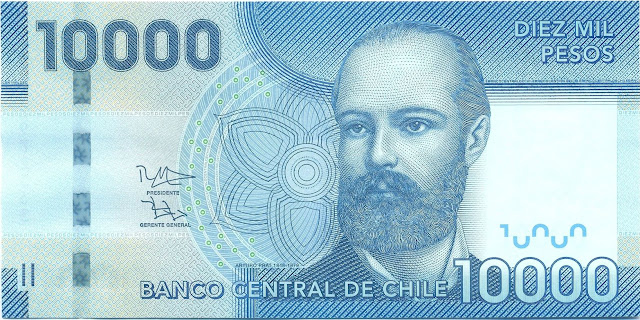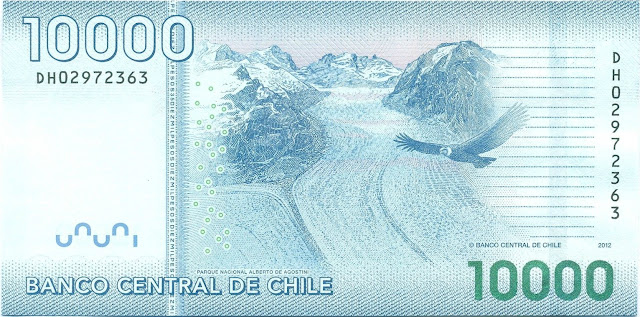Chile Banknotes 10000 Pesos banknote 2012 Arturo Prat
Central Bank of Chile - Banco Central de Chile
Obverse: Portrait of the Chilean lawyer and navy officer Agustin Arturo Prat Chacón (1848-1879); Number 10000 as registration device. Centered is stylized Lapageria. Two security threads: Horizontally, along whole field of the banknote, micro printing repeated "Diez Mil Pesos" over the entire length of the strips. Bottom left are two vertical bars for the visually impaired. Denominations in numerals are top left and bottom right, in words top right.
Reverse: Condor flying above the glaciers and the Cordillera Darwin mountain range in the Alberto de Agostini National Park. Number 10000 as registration device. Denominations in numerals are top left and bottom right.
Watermark: The portrait of Agustin Arturo Prat Chacón and electrotype "10 MIL".
Signatures of Rodrigo Vergara (as PRESIDENTE) and Alejandro Zurbuchen Silva (as GERENTE GENERAL). Wide windowed security thread on front. Additional solid security thread. OMRON™-rings on both sides. One horizontal and one vertical 8-digit serial number on the reverse, both with double letter prefix and numerals of the same size.
Printed by Tumba Bruk (Crane and Co.), Tumba, Sweden.
Chile banknotes - Chilean paper money
2009-2013 Issue
Arturo Prat
Agustín Arturo Prat Chacón (April 3, 1848, near Ninhue, Chile – May 21, 1879, Iquique, Peru) was a Chilean lawyer and navy officer. He was killed shortly after boarding the Peruvian armored monitor Huáscar at the Naval Battle of Iquique after the ship under his command, the Esmeralda, was rammed by the Peruvian monitor. Prat, as captain of the Esmeralda, was the first to board the Huáscar.
During his career, Prat had taken part in several major naval engagements, including battles at Papudo (a coastal city north of Valparaíso) (1865), and at the Battle of Abtao (1866), at the islet of Abtao across from Chiloé Island. Following his death, his name became a rallying cry for Chilean forces, and Arturo Prat has since been considered a national hero.
Prat's name is commemorated on numerous plazas (squares), streets, buildings and other structures in Chile. His name has been commemorated by four of Chile's major warships, including a USS Brooklyn class cruiser in the 1950s, a British County class destroyer from 1983 to 2006, and most recently a Dutch Jacob van Heemskerck class frigate transferred to Chile as Capitan Prat in 2006. One of Chile's Antarctic research facilities, Arturo Prat Station, and the Chilean Naval Academy, Escuela Naval Arturo Prat are named after him. His portrait appears on the 10,000 Chilean peso bank note. Also, in 1984 Arturo Prat University was founded, with its main campus in Iquique where his heroic deed took place.
Condor
The Andean condor (Vultur gryphus) is a South American bird in the New World vulture family Cathartidae and is the only member of the genus Vultur. Found in the Andes mountains and adjacent Pacific coasts of western South America, the Andean condor has a wingspan of up to 3.2 m/10.5 ft but is exceeded by the wandering albatross (at up to 3.6 m/12 ft), the southern royal albatross, the Dalmatian and the great white pelicans (at reportedly up to 3.5 m/11.6 ft).
It is a large black vulture with a ruff of white feathers surrounding the base of the neck and, especially in the male, large white patches on the wings. The head and neck are nearly featherless, and are a dull red color, which may flush and therefore change color in response to the bird's emotional state. In the male, there is a wattle on the neck and a large, dark red comb or caruncle on the crown of the head. Unlike most birds of prey, the male is larger than the female.
The condor is primarily a scavenger, feeding on carrion. It prefers large carcasses, such as those of deer or cattle. It reaches sexual maturity at five or six years of age and nests at elevations of up to 5,000 m (16,000 ft), generally on inaccessible rock ledges. One or two eggs are usually laid. It is one of the world's longest-living birds, with a lifespan of over 70 years in some cases.
The Andean condor is a national symbol of Argentina, Bolivia, Chile, Colombia, Ecuador, and Peru and plays an important role in the folklore and mythology of the Andean regions. The Andean condor is considered near threatened by the IUCN. It is threatened by habitat loss and by secondary poisoning from carcasses killed by hunters. Captive breeding programs have been instituted in several countries.
Alberto de Agostini National Park
Alberto de Agostini National Park is a Protected Area created on land that was formerly part of "Hollanda" forest reserve and "Hernando de Magallanes National Park". It covers 14,600 km2 (5,637 sq mi) and includes the Cordillera Darwin mountain range, which is the final land-based stretch of the Andes before it becomes a chain of mountains appearing as small islands that sink into the Pacific Ocean and the Beagle Channel.
The park, along with Cabo de Hornos National Park, was designated a Biosphere Reserve by UNESCO in 2005. As part of the Magallanes Sub-Polar (or Sub-Antarctic) Evergreen Rainforest, UNESCO highlights the area’s "mosaic of contrasting ecosystems and unique and singular characteristics on a world level."
Several tidewater glaciers and steep fjords can be found in the park. It also comprises the Gordon, Cook and Londonderry islands, as well as part of Hoste Island (excluding the Hardy Peninsula and other portions).

